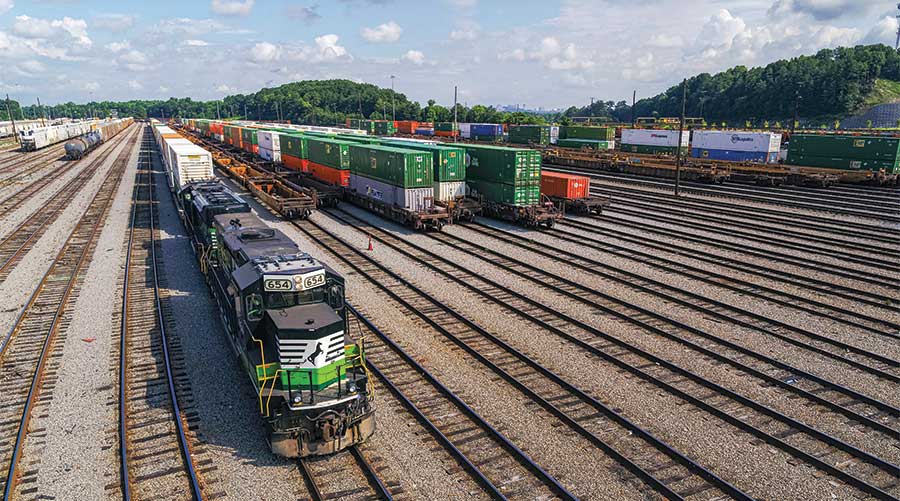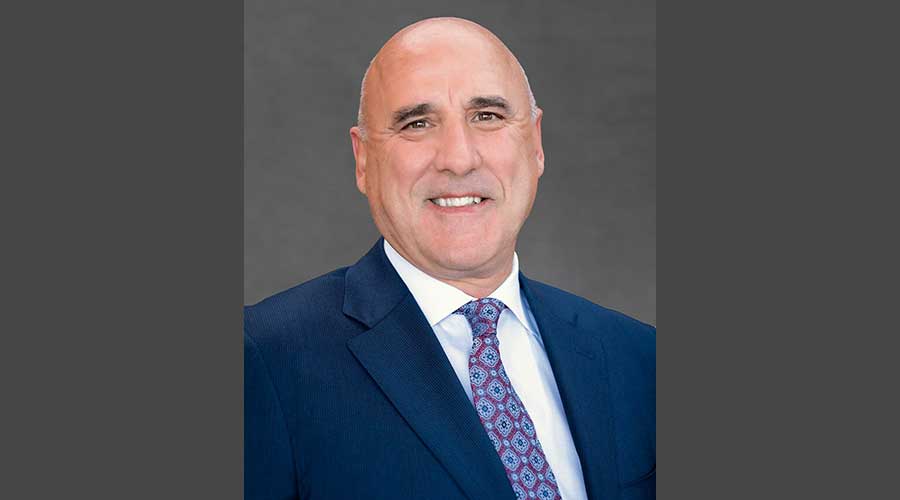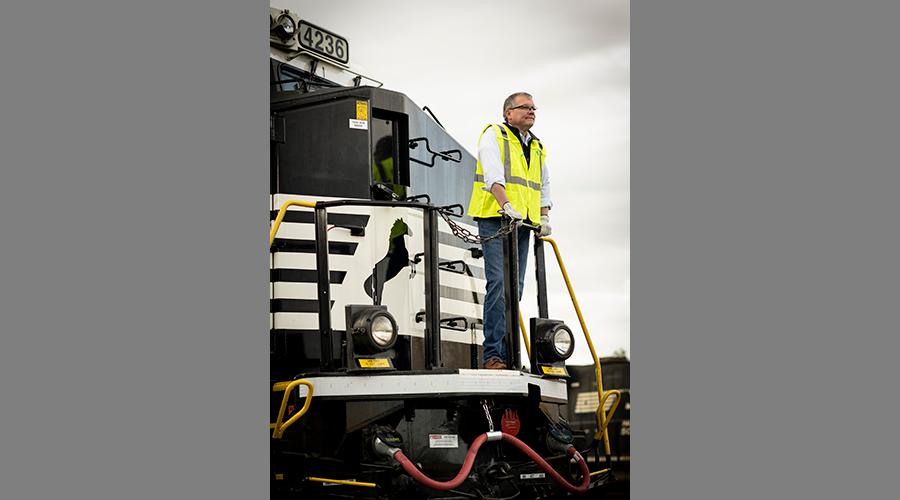Stay updated on news, articles and information for the rail industry
August 2016
Rail News: Norfolk Southern Railway
Norfolk Southern pours capital, sweat equity into its new Premier Corridor

By Jeff Stagl, Managing Editor
The Crescent. The Heartland. The MidAmerica. The Patriot. Norfolk Southern Corp. has developed a number of corridors over the past few decades, either on its own or with other railroads. But the aptly named and recently introduced Premier Corridor might be its pre-eminent one.
Stretching about 900 miles across three NS operating divisions between Chicago and northern New Jersey, the double-tracked corridor is one of the busiest and fastest links in the Class I’s 22-state network. The railroad created it earlier this year by tying together more than a dozen key districts and routes — including the Chicago, Cleveland, Fort Wayne, Pittsburgh, Harrisburg, Lehigh and Port Road lines — and branding it as the Premier Corridor.
The new East-West artery runs through several high-population, consumer-rich markets in the Midwest, Northeast and Mid-Atlantic, including Baltimore and Philadelphia, and accesses large eastern ports, providing shippers a gateway to world markets.
As many as 230 intermodal, bulk commodity and general merchandise trains now use some portion of the Premier daily. NS trains pick up or deliver freight at more than 140 facilities that serve over 800 merchandise shippers.
The corridor is a vital passageway for U.S. steel manufacturers, including mills in northern Indiana, the nation’s largest steel-producing region. About 45 percent of U.S. raw steel production occurs at mills located along the Premier between Chicago and Harrisburg, Pa.
How much intermodal traffic flows along the corridor? The intermodal segments handled on the Premier and their share of NS’ total annual volume in that particular category are: premium (time-sensitive parcels), 57 percent; domestic, 50 percent; and international, 31 percent.
In addition, about 28 percent of total chemical shipments, 26 percent of overall metals/construction materials traffic and 16 percent of total automotive loads traversed the corridor’s lines in 2015.
The Premier — parts of which date back to the earliest days of railroading — includes portions of the former New York Central and Pennsylvania railroads, and track and facilities previously operated by Conrail.
It is part of the Class I’s “Golden Triangle” that connects Chicago, Harrisburg and Atlanta, three cities through which 90 percent of NS’ yearly intermodal volume originates, terminates or passes through.
The high-volume, high-density Premier Corridor is a crucial set of routes and connections that are strategically intermingled and integrated, says NS Vice President of Strategic Planning John Friedmann.
“The corridor is greater than the sum of its routes. It’s really about how the routes tie together,” he says.
The Premier provides the Class I market and commodity flexibility, and network recoverability, says Friedmann.
“It’s a tremendous corridor for us, and not just for intermodal, but for coal and merchandise freight,” he says. “It’s a value proposition for all types of traffic.”
Of capital importance for infrastructure
To ensure it retains that standing — and enables the company to mine lucrative markets as intended — NS leaders aim to continue plowing capital into infrastructure upgrades and improvements on the corridor. Last year, the company spent $95.5 million and $30.5 million to maintain track and boost capacity, respectively, on the Premier’s lines.
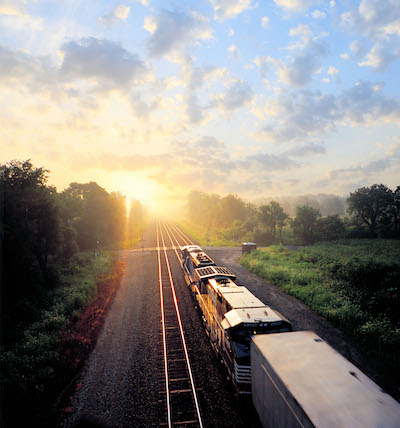 The double-tracked Premier Corridor runs about 900 miles from Chicago to northern New Jersey and travels through such large markets as Cleveland, Baltimore, Pittsburgh and Philadelphia. Norfolk Southern Railway
The double-tracked Premier Corridor runs about 900 miles from Chicago to northern New Jersey and travels through such large markets as Cleveland, Baltimore, Pittsburgh and Philadelphia. Norfolk Southern RailwayHowever, the Class I’s braintrust believes the company needs to be cautious about investing too early in infrastructure upgrades and allotting capital to lines that might not have the diverse traffic to support it. Their thinking: Infrastructure doesn’t earn a return on investment sitting in the ground waiting for traffic to develop, and several sectors can still grow business if volume in one particular commodity declines. The strategy, which helps ensure a return on investments, plays well on the traffic-diverse Premier Corridor, NS leaders believe.
So does capacity planning. Since it takes at least a year to add or create infrastructure where needed, and complicated projects can take even longer, NS strategists use a LineMAX capacity analyzer to help evaluate capacity needs. The in-house tool enables them to simulate traffic flows across the network and analyze specific segments to determine where there’s sufficient capacity and where it might need to be added. They use LineMAX to monitor and manage capacity across the Premier.
The Class I has stressed aggressive infrastructure investments along the corridor’s lines the past five years to replace rail, ties and ballast, add and extend sidings, build support track and expand facilities, says Ed Boyle, NS’ assistant VP of maintenance of way and structures. More work needs to be done to keep up with traffic demands and needs, accommodate more volume and enhance operational reliability, but not as much on the infrastructure-addition end, he says.
“We’ve done a lot of work on capacity the past four to five years, so we won’t do as much going forward,” says Boyle. “We will continue to do a lot of maintenance work each year.”
Yet, there’s more that can be done by way of adding or enhancing track connections, NS executives say. The late 2014 completion of the major expansion to Moorman Yard in Bellevue, Ohio — NS’ biggest classification yard, which is named after former NS Chairman, President and Chief Executive Officer Wick Moorman (who on Sept. 1 becomes president and CEO of Amtrak) — prompted an examination to determine if better connections were needed because of how lines feed into and out of the facility.
Located near the Premier, the 5.5-mile-long Moorman Yard plays a key role in the movement of traffic to and from Chicago, and contributes to the operating efficiencies of other yards that serve customers from Pennsylvania to northern Indiana.
As a result of the analysis, the Class I now is building a reverse connection in Vermilion, Ohio, that’s designed to smooth traffic flow along a portion of the Premier. The $12.5 million connection will enable eastbound trains to move off the formerly named Chicago Line between the Windy City and Cleveland — the railroad’s busiest line that accommodates 100 trains per day, including 14 Amtrak trains — and onto the B-Line, a parallel NS mainline that provides access to New England and upstate New York markets. The B-Line doesn’t have as much capacity as the Chicago Line, but doesn’t host as many trains.
'More bang for the buck'
Involving the construction of less than a mile of track, the reverse connection will enable trains bound for Buffalo, N.Y., and points in New England to avoid busy Chicago Line traffic around downtown Cleveland, says Friedmann. Roadbed and grading work is slated for completion this year and the track will be constructed in 2017.
The tracks in the area don’t cross at grade, so it’s necessary to construct the connection track, says Friedmann. A connection that previously was built in Vermilion in anticipation of the Conrail split in 1999 enables NS to route traffic on the Chicago Line to Moorman Yard.
Track connections in general tend to be cheaper because they are short and can be built on land already owned, as opposed to sidings that are longer and more expensive to construct, says Friedmann.
“We can get more bang for the buck,” he says.
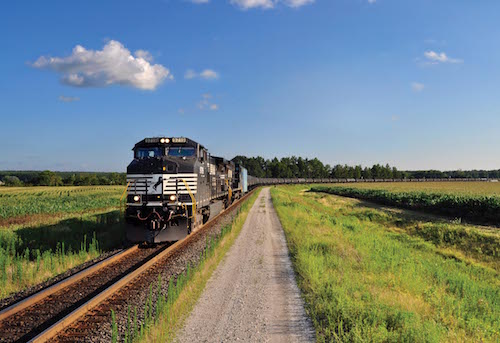 Last year, about 28 percent of total chemical shipments in the United States traversed the corridor’s lines. Norfolk Southern Railway
Last year, about 28 percent of total chemical shipments in the United States traversed the corridor’s lines. Norfolk Southern RailwayNS also hopes to gain more bang for the Premier Corridor from the Indiana Gateway, a series of eight projects the Class I is working on between Porter and Hammond, Ind., with Amtrak, the Indiana Department of Transportation and Federal Railroad Administration via a $71 million public-private partnership (PPP).
The projects — seven of which are located on the Chicago Line and the other on Amtrak’s Michigan Line — involve universal crossovers and new signaling equipment at five locations. In addition, 6.5 miles of track will be built, including a third mainline at three locations totaling 12 miles of triple track.
The Indiana Gateway also includes a new passing siding to be constructed where NS, CSX and Amtrak trains intersect. Each day now, 14 Amtrak trains share the existing tracks with 90 freight trains.
The projects are designed to improve some of the busiest tracks in the nation, boost capacity, and increase fluidity for freight and passenger trains.
NS crews are performing all the Chicago Line work for the Indiana Gateway and the projects should be completed by 2016’s end, says Boyle. Including its participation in PPPs, NS over the years has provided funds for Chicago Line infrastructure improvements totaling more than $750 million.
Unique approach on Indiana bridge
That includes a bridge project the railroad completed near Porter last year. NS replaced a 185-foot open-deck bridge over the Little Calumet River with a 210-foot ballast-deck bridge over a two-year period by constructing two bridges off line. The unique approach of building bridges outside each track ensured the work didn’t impede the line’s traffic, says Boyle.
“It’s the first time we built bridges off line this way. We learned from the project that it can work,” he says. “We’re looking at other points along the Premier Corridor where we could do this.”
In the meantime, a large Chicago Line project is set to start sometime in the near term: the addition of four crossovers between Elkhart, Ind., and the Windy City. The project, which as of press time had no definite start date, will help improve fluidity and operational flexibility, says Boyle.
Yet, throwing capital at an operational problem or need isn’t always the answer. Sometimes, there are process improvements that could be made instead, such as a way to debottleneck a system, or institute operational or service changes.
To that end, NS officials a year ago eliminated some work events at Airline Yard in Toledo, Ohio. They moved interchanges out of the city and reduced the number of trains making stops to pick up cars, says Mike Grace, an NS division superintendent who’s responsible for Chicago Line operations.
“We continue to review the operating plan and look at chokepoints,” he says, adding that such an analysis helps determine if a problem is caused by a volume or an operating plan issue.
Tweaking the operating plan is an ongoing challenge because the Chicago Line needs to meet train speed and on-time performance (OTP) goals, says Grace. Amtrak trains travel at 79 mph while NS trains need to average about 25 mph to 26 mph, including moves into and out of yards, he says. The OTP goal is 100 percent, and the line has been averaging a percentage in the mid-80s.
“It’s like a chess game, with so many trains,” says Grace, who manages 1,800 transportation department workers assigned to handle the line’s 100 daily trains.
Railroad employees take ownership of line
It helps that many of the line’s workers have “pride in ownership” in supporting operations, he says. For example, a conductor last winter rode an intermodal train that had gotten stuck behind another train for 10 miles as a shove move, which helped free it.
“We said he didn’t have to do that. He said he didn’t want the intermodal train to be late,” says Grace. “We have the best management and people on the line. There’s a sense of urgency, a need to focus on problems, so they gain attention 24/7.”
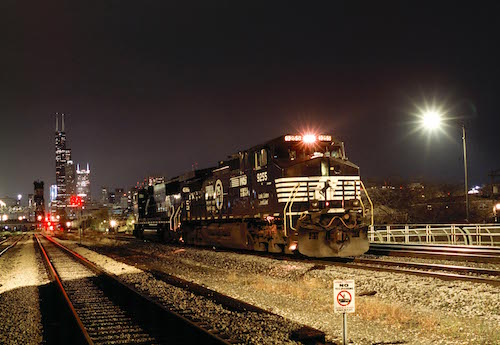 NS is expanding and upgrading several Chicago-area terminals in part to boost capacity for the Premier Corridor. Norfolk Southern Railway
NS is expanding and upgrading several Chicago-area terminals in part to boost capacity for the Premier Corridor. Norfolk Southern RailwayIn addition to a big contribution from employees, NS is gaining a sizable operational assist for both the Chicago Line and Premier Corridor from expansions and improvements at several Windy City terminals. The railroad is expanding its 47th Street terminal — NS’ busiest intermodal facility in Chicago — as well as the 63rd Street and Calumet yards. To be completed by year’s end, the projects include the construction of support and pad tracks, and more trailer parking areas, says Boyle.
In addition, the Class I is expanding both the Airline Yard in Toledo and a yard in Burns Harbor, Ind., and expects to cap off that work by 2016’s end, as well. The Toledo facility will gain track additions and the Burns Harbor yard — which is located near a port that handles coal and metals traffic — will gain rail extensions and yard capacity improvements, says Boyle.
Capacity-wise, NS is in pretty good shape on the Premier Corridor to support both intermodal and automotive volumes, says VP of Intermodal and Automotive Jeff Heller. Most automotive traffic passes through the corridor to reach Northeast consumer markets, including those in New York and New Jersey. Trains that operate along the Premier also help move autos to western states via interchanges with other Class Is in Chicago.
The intermodal effect
In terms of total intermodal traffic, about 1.6 million loads — or 43 percent of NS’ annual volume — were moved on the corridor’s lines in 2015, including domestic, international and premium service loads.
To support international traffic, NS has the capacity to grow loads moving either east or west, says Heller.
“We have significant flexibility to move volumes as demand changes,” he says.
For domestic, or 53-foot container, business, four of NS’ five intermodal terminals in Pennsylvania are tied to the Premier. Having a lot of capacity in the state is important because ground zero of eastern domestic activity has shifted over the past several years from New York and New Jersey to Pennsylvania due to population changes and port/highway congestion, says Heller.
Domestic traffic is where the volume growth is, and loads moving from Chicago to Harrisburg are “the sweet spot,” he says. The traffic moves quickly, too: An intermodal train traveling from NS’ 47th Street facility in Chicago to Harrisburg covers about 730 track miles in 24 hours.
Meanwhile, time-sensitive premium intermodal business is growing, as well. The reason: the significant reliability of the Class I’s network, including operations on the Premier.
“As we run better, it opens opportunities,” says Heller.
For the railroad, there are many business-building opportunities that could be seized along the fledgling corridor, NS execs believe. The Class I already moves such a large volume and variety of freight on it, there’s a good chance that any retail product bought by a consumer somewhere in the nation includes raw materials or components that were transported on the corridor’s lines.
“We see it as the ‘Premier’ route,” says Heller. “It has a lot of capacity, a lot of flexibility and a lot of traffic.”


 2025 MOW Spending Report: Passenger-rail programs
2025 MOW Spending Report: Passenger-rail programs
 Gardner steps down as Amtrak CEO
Gardner steps down as Amtrak CEO
 Guest comment: Oliver Wyman’s David Hunt
Guest comment: Oliver Wyman’s David Hunt
 Women of Influence in Rail eBook
Women of Influence in Rail eBook
 railPrime
railPrime





